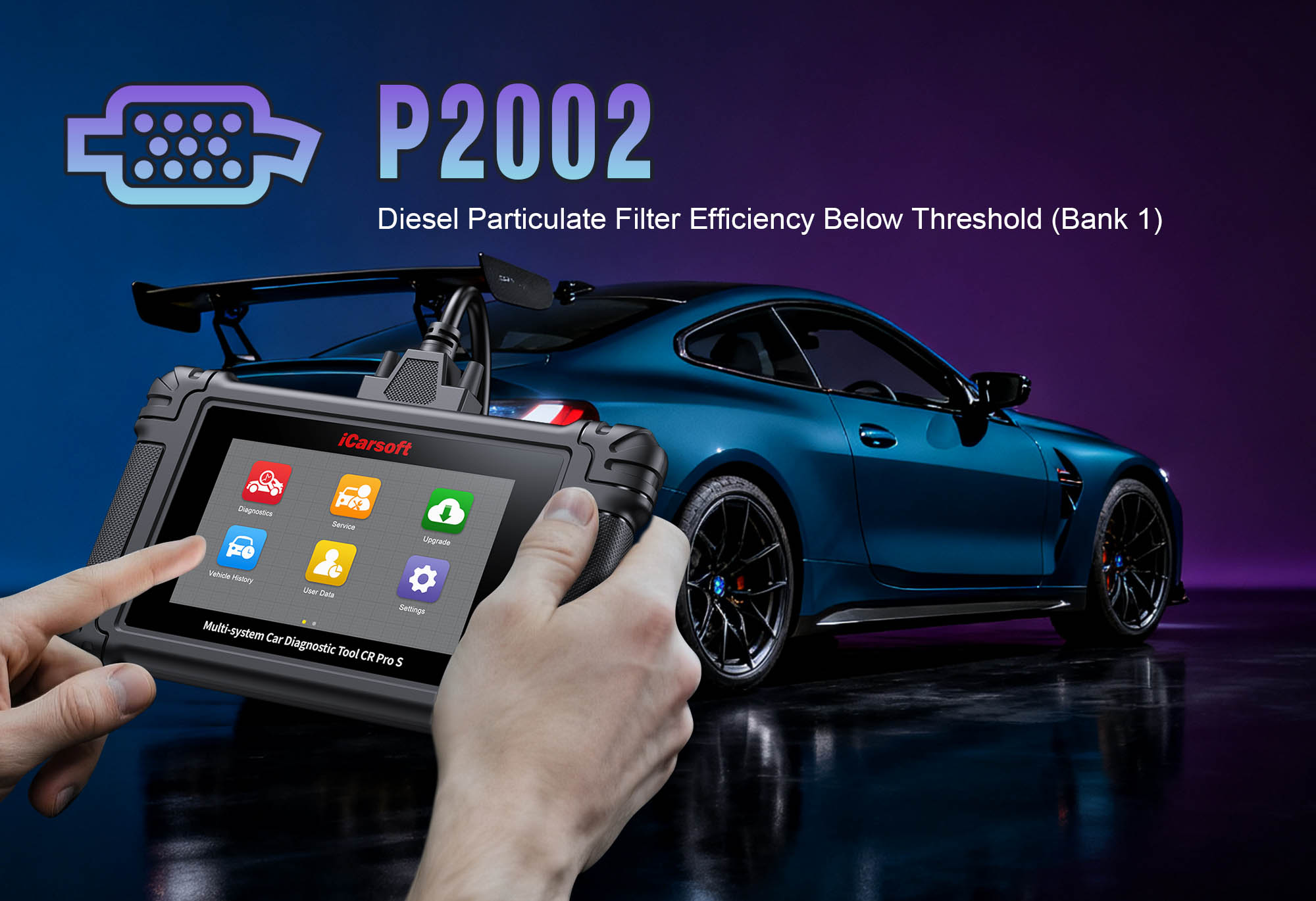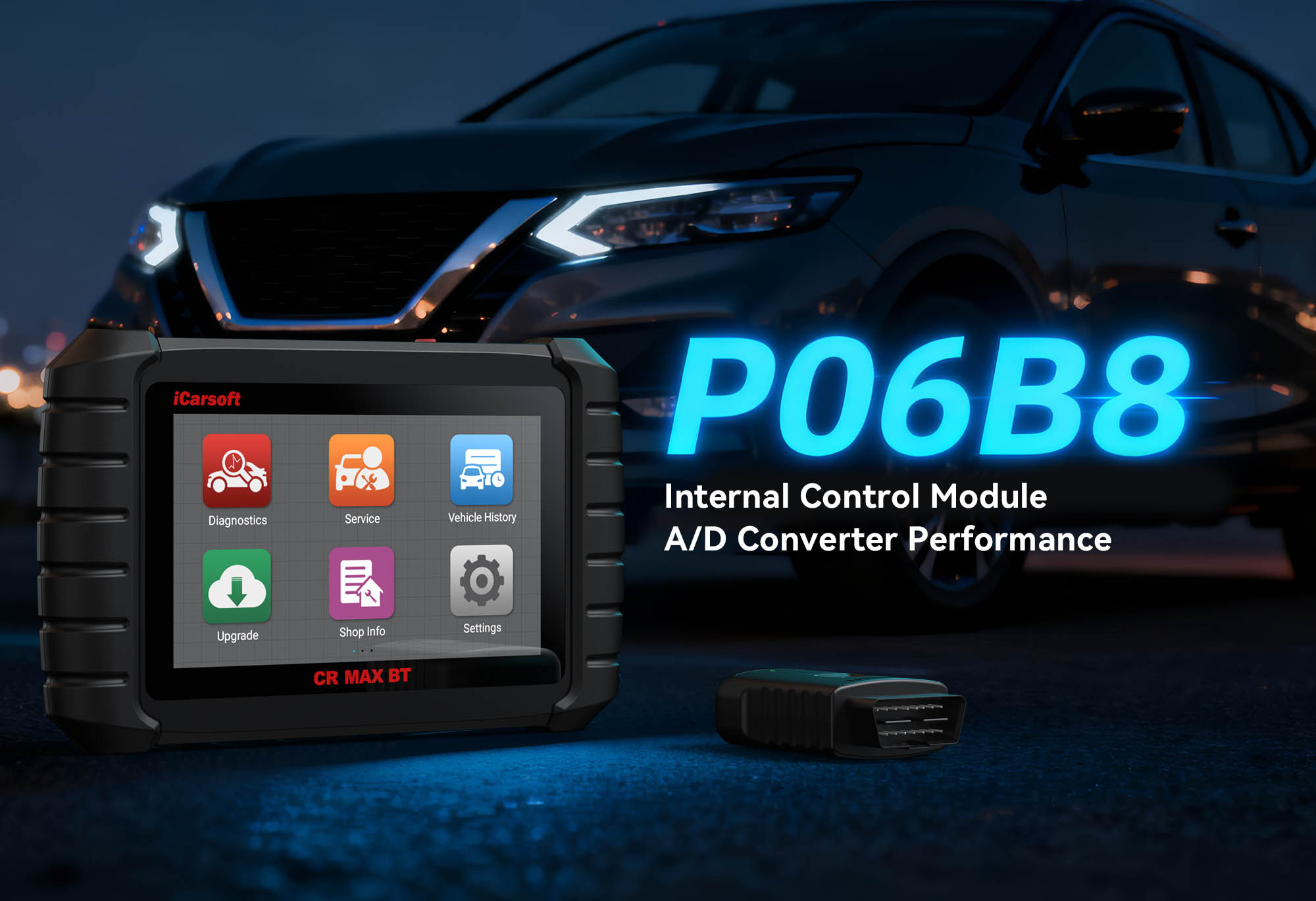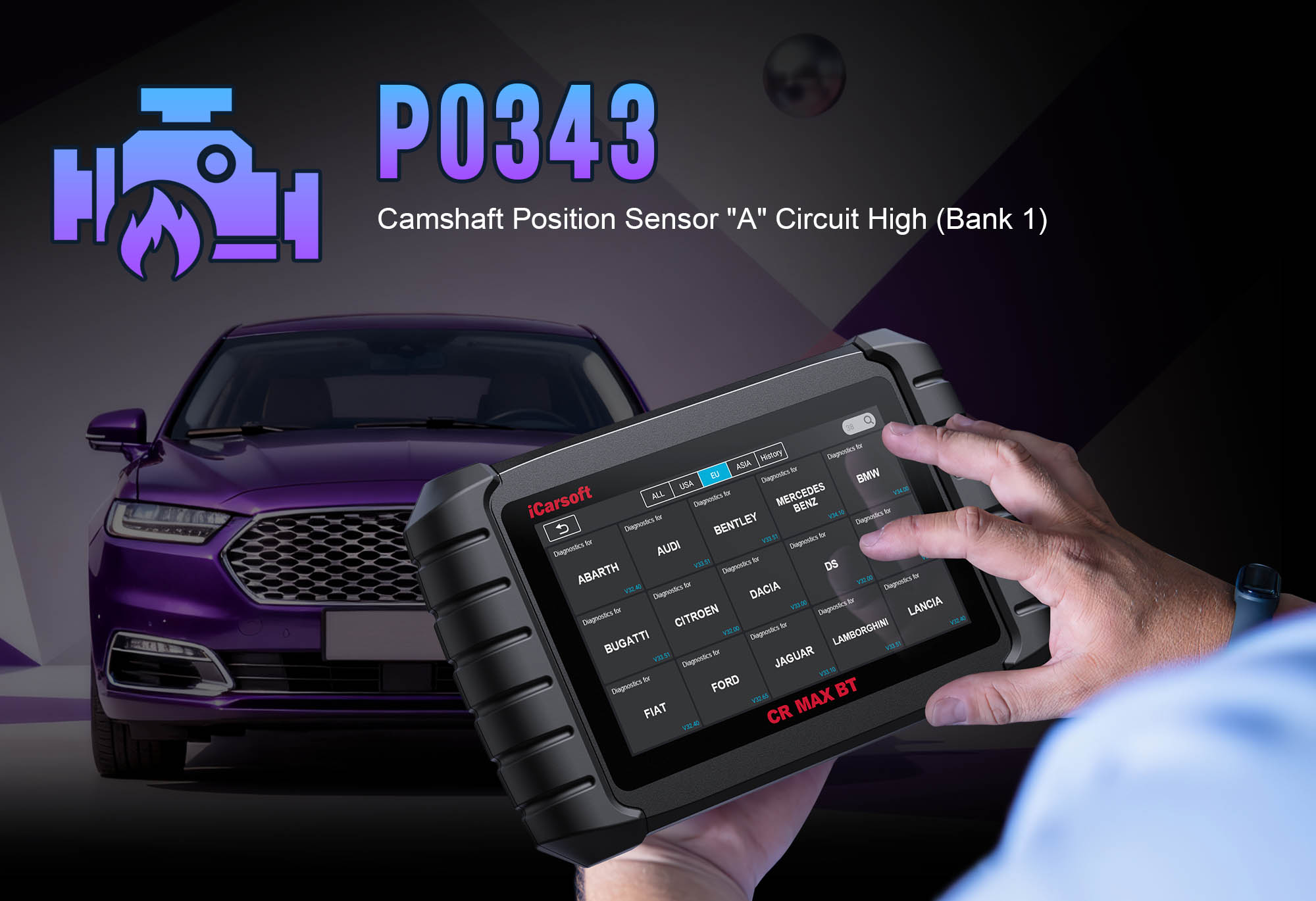Diagnose & Clear P2002 with iCarsoft CR Elite P: Fix Diesel Particulate Filter (DPF) Efficiency Below Threshold
Diagnose & Clear P2002 with iCarsoft CR Elite P: Fix Diesel Particulate Filter (DPF) Efficiency Below Threshold
If your diesel vehicle’s check engine light illuminates, you notice reduced acceleration, or the "DPF Regeneration Required" warning flashes, a diagnostic scan will likely return P2002. This OBD-II code stands for "Diesel Particulate Filter (DPF) Efficiency Below Threshold"—a critical fault where the DPF (which traps harmful exhaust soot) no longer filters particles effectively. A clogged/damaged DPF disrupts exhaust flow, triggers limp mode, and risks turbocharger or catalytic converter damage if ignored.
Basic scanners can’t monitor DPF pressure or initiate regeneration, but the iCarsoft CR Elite P’s diesel-specific diagnostics solve this. Let’s walk through diagnosing and resolving P2002 with precision.
Understanding P2002: Causes & Key Symptoms
DPF efficiency drops when soot isn’t burned off (via regeneration) or the filter is damaged—symptoms worsen as exhaust flow is blocked:
Key Symptoms of P2002
-
Check Engine Light + DPF Warning Light: CEL triggers for P2002; amber DPF light flashes (full clog) or stays solid (low efficiency).
-
Reduced Engine Power (Limp Mode): ECM limits power to 30–40 mph to prevent damage—acceleration becomes sluggish.
-
Increased Fuel Consumption: Exhaust backpressure forces the engine to work harder—fuel usage rises by 15–20%.
-
Rough Idle & Exhaust Smoke: Soot buildup disrupts idle; unfiltered particles escape as black smoke from the tailpipe.
-
Regeneration Failure: Automatic regen (burns soot) fails repeatedly—"Regen In Progress" light turns off prematurely.
-
Turbocharger Lag: Backpressure reduces turbo boost—delayed acceleration when merging or climbing hills.
Common Causes of P2002
|
Cause
|
Description
|
|
Excessive DPF Soot Buildup
|
Short trips (<10 mins) prevent regen temperatures (>250°C)—soot accumulates faster than it’s burned.
|
|
Failed DPF Regeneration
|
Faulty temperature/pressure sensors or injectors disrupt regen—soot isn’t cleared from the filter.
|
|
Damaged DPF Filter
|
Physical damage (road debris) or thermal shock creates holes—soot bypasses the filter.
|
|
Clogged DPF Pressure Tubes
|
Soot clogs tubes connecting pressure sensor to DPF—false readings trick ECM into thinking DPF is inefficient.
|
|
Faulty DPF Sensors
|
Broken temperature/pressure sensors send incorrect data, triggering false P2002 codes.
|
|
Low-Quality Diesel Fuel
|
High-sulfur fuel produces excess soot, overwhelming the DPF (illegal in most regions but still available).
|
Why iCarsoft CR Elite P Excels at Diagnosing P2002
The CR Elite P outperforms basic tools with diesel DPF-specific features:
Live DPF Soot Load Monitoring
Tracks real-time soot accumulation (grams) — values >60g = severe buildup; >80g = risk of permanent damage.
Forced DPF Regeneration
Initiates manual regen to burn soot—works even if automatic regen fails (e.g., due to short trips).
DPF Pressure & Temperature Tracking
Monitors exhaust backpressure (1–5 psi normal) and filter temp—identifies clogs or sensor faults.
DPF Sensor Tests
Verifies temperature/pressure sensor functionality—rules out false readings causing P2002.
Global Diesel Coverage
Works with 500+ diesel models (Ford Power Stroke, Toyota Hilux) — supports passive/active DPF systems.
DPF Health Reports
Generates soot load/regen history logs—determines if DPF can be saved (regen) or needs replacement.
Step-by-Step: Diagnose P2002 with iCarsoft CR Elite P
-
1. Check DPF Warning Lights & Initial Symptoms
Assess basic DPF health before using the tool:
1. Warning Lights: Flashing DPF light = full clog (immediate action); solid = low efficiency.
2. Driving Habits: Short trips = likely soot buildup (regen needs 20+ mins of highway driving).
3. Exhaust Smoke: Black smoke = damaged DPF or injector issues.
-
2. Connect the CR Elite P & Confirm P2002
1. Plug into OBD-II port (use adaptors for older diesel OBDI models).
2. Select AutoVIN Identify to detect diesel engine/DPF type.
3. Navigate to Engine > Fault Codes to confirm P2002—check Code Details (e.g., "Ford F-250: Soot Load 72g, Max 60g").
4. Resolve related codes (P0401/P2422 = EGR/DPF sensor faults) first.
-
3. Monitor Live DPF Data
Real-time data reveals root cause:
1. Start engine, idle 5 mins (warms DPF).
2. Navigate to Engine > Live Data > DPF System and monitor:
- Soot Load: >60g = regen needed; <30g = check sensors/damage.
- DPF Pressure: >10 psi = clogged DPF/tubes; <1 psi = sensor fault.
- DPF Temperature: <100°C at idle = faulty temperature sensor.
- Regen Status: "Failed" = sensor/injector issue.
-
4. Test DPF Pressure & Temperature Sensors
Rule out faulty sensors:
1. Pressure Sensor Test: - Locate via Component Location > Engine > Exhaust System > DPF Pressure Sensor.
- Clean clogged tubes with compressed air; run Special Functions > DPF > Pressure Sensor Test—erratic readings = replace sensor.
2. Temperature Sensor Test: - Disconnect sensor, use multimeter (Ohms) — normal = 100–200 ohms (25°C); out-of-range = replace.
- Reconnect, monitor live temp—pre-DPF temp should be 50–100°C higher than post-DPF.
-
5. Perform Forced DPF Regeneration (High Soot Load)
Burn off excess soot:
1. Pre-Regen Checks: Engine temp >80°C, fuel >1/4 tank, park in well-ventilated area.
2. Start Regen: Navigate to Special Functions > DPF > Forced Regeneration—engine RPM rises to 2,500–3,000 RPM for 20–40 mins.
3. Monitor Temp: DPF temp should reach 500–600°C; <400°C = sensor/injector fault.
4. Post-Regen: Soot load drops to 5–15g; clear P2002 and restart engine.
-
6. Clean Clogged DPF Pressure Tubes (Abnormal Pressure)
Fix false pressure readings:
1. Disconnect pressure tubes from sensor/DPF (loosen clamps with pliers).
2. Blow compressed air through tubes (both ends) to remove soot; use small wire brush for heavy clogs.
3. Reattach tubes, monitor pressure—should return to 1–5 psi at idle.
-
7. Inspect for DPF Damage (Normal Soot Load)
Check for holes/bypass:
1. Visual Inspection: Locate DPF (under vehicle) — look for dents/cracks; hold to light—no light should pass through (light = holes).
2. Smoke Test: Run Special Functions > Engine > Exhaust Smoke Test—>0.5 g/kWh = damaged DPF (replace).
-
8. Repair & Clear P2002
Fix root cause:
1. High Soot Load: Complete regen + add weekly highway trips.
2. Faulty Sensors: Replace with OEM parts (use Part Lookup, e.g., Ford BC3Z-5L227-A).
3. Clogged Tubes: Clean/replace tubes.
4. Damaged DPF: Install EPA-compliant replacement (never remove DPF—illegal).
5. Clear code via Engine > Fault Codes > Clear Codes.
-
9. Validate the Repair
Ensure DPF functionality:
1. Test drive 30–40 mins (highway + city) — no power loss/smoke; smooth acceleration.
2. Monitor post-repair data: Soot load <30g for 1,000+ miles; pressure 1–5 psi at idle.
3. Run I/M Readiness Test for emissions compliance.
Preventing P2002 Recurrence
Use the CR Elite P to maintain DPF health:
-
Regular Regen Checks: Review DPF Regen History—schedule forced regens if automatic ones fail.
-
Soot Load Monitoring: Set Service Reminder to check soot load every 5,000 miles—regen early.
-
Fuel Quality: Use ultra-low sulfur diesel (ULSD); add DPF cleaner every 10,000 miles (check Fuel System Guide).
-
Sensor Maintenance: Clean DPF sensor connectors every 15,000 miles with electrical contact cleaner.
Conclusion
P2002’s DPF efficiency fault is a top issue for diesel owners, but the iCarsoft CR Elite P turns it into a manageable fix. By enabling forced regen, sensor testing, and live data monitoring, this tool saves thousands on unnecessary DPF replacements—many cases are resolved with a simple regen or sensor cleaning.
For DIY diesel enthusiasts and professionals, the CR Elite P’s diesel-specific features and global coverage make it the ideal tool for resolving P2002. Restore DPF efficiency, regain engine power, and stay emissions-compliant—all with one professional-grade diagnostic tool.
FAQs About P2002 Code
Q: Can I drive with P2002?
A: Short distances are okay, but prolonged driving triggers limp mode and risks turbo damage. Address it within 100 miles—prioritize forced regen if soot load is high.
Q: How much does it cost to fix P2002?
A: $0 (forced regen via CR Elite P) to $200 (sensor replacement); $1,500–$4,000 for DPF replacement. The tool avoids overspending on unnecessary DPF swaps.
Q: Why does P2002 return after regen?
A: Unresolved issues—clogged pressure tubes, faulty sensors, or damaged DPF. Use the CR Elite P to retest pressure/temp sensors and inspect for DPF holes.
Q: Is it legal to remove the DPF to fix P2002?
A: No—DPF removal is illegal in most regions (violates emissions laws) and results in failed inspections, fines, or voided warranties. Always replace damaged DPFs with EPA-compliant parts.





